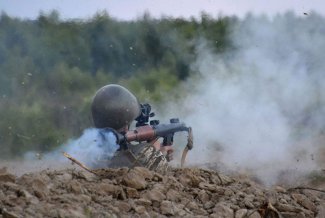Recruitment starts for the Ukrainian Legion. Day 957 of the war

![]()
During the week following pushing Ukrainian troops out of Vuhledar, the Russians made no attempt to develop their success and launch a strong strike against the retreating enemy. The development of the situation near this town is therefore similar to the final phase of the Battle of Avdiivka in February this year, when – after four months of heavy fighting and the capture of the Ukrainians' main point of resistance – the Russians had to focus on replenishing their losses and regrouping their forces, and thus gave the enemy time to prepare new defensive lines. According to available information, the covering troops of the Ukrainian 72nd Mechanised Brigade left Vuhledar overnight on 30 September and 1 October. The losses sustained by the Ukrainian side during the retreating manoeuvre were high, with at least dozens of dead or missing without a trace; in addition, at least five Ukrainian soldiers were said to have been shot by the Russians in Vuhledar immediately after being taken prisoner.
The Russians are continuing their offensive operation in the Donbas, concentrating their efforts towards the towns of Pokrovsk and Kurakhove. The heaviest fighting is taking place in the vicinity of the villages of Hostre and Maximilianivka (5 to 10 km east of Kurakhove) and in the area of Selydove and Hirnyk. The situation north and south of Selydove is taking an unfavourable turn for Ukraine. For several weeks, the aggressor's objective has been to outflank this town with assaults by small groups of infantry, moving slowly out of the tightly built-up area. To the south of it, the Russians have taken the settlement of Tsukuryne and have been held up on the railway line. The resistance point at Selydove is currently the most serious obstacle to the Russians' movement westwards and a key element of the Ukrainian defence system between Pokrovsk and Kurakhove.
Urban fighting also continues in Toretsk and the Niu-York area. Despite the high activity of Russian assault groups, the Ukrainians are managing to keep the situation under control in this area. The stabilisation of this section of the front was helped, among other things, by the transfer of the 12th Brigade of the 'Azov' National Guard here a few weeks ago. At the beginning of September, the commander of the Luhansk tactical-operational group, responsible for the section stretching from the Donets near Siversk to the vicinity of Niu-York, was also changed. This position is currently held by Mykhailo Drapatyi, regarded as one of the most talented younger Ukrainian generals.
![]()
Over the past week, the Russians have attacked Ukraine daily with more than 350 suicide drones (Shahed 131/136 and other types). According to the Ukrainian Air Force Command, 207 of them were shot down, 112 were jammed by radio-electronic warfare means and six flew into Russian or Belarusian airspace. At least 25 drones reached their targets, destroying, among other things, the infrastructure of border crossings and ports on the Danube (Odesa region).
From 2 to 8 October, Russia also used several ballistic and cruise missiles. On 7 October, three Kinzhal hypersonic missiles were launched, two of which are thought to have been shot down by Ukrainian air defences near Kyiv, and one reached its target in the area of Starokostiantyniv airport (Khmelnytskyi region). Russia appears to be attempting to destroy the airport infrastructure used by F-16 aircraft. In addition, on 7 October, a ballistic missile hit the port of Odesa, damaging a merchant ship and killing one person. Russia has also attacked frontline cities with aerial guided bombs, causing damage to civilian infrastructure in Kharkiv, Zaporizhzhia and Kherson, among others.
On 3 October, the head of the Donetsk Oblast administration, Vadym Filashkin, reported that, due to shelling and bombardment, drinking water supplies had been stopped to Sloviansk, Kramatorsk, Druzhkivka, Kostiantynivka and surrounding villages, affecting a total of around 260,000 people.
![]()
On 1 October, the Ukrainian government amended the legislation governing conscription for military service. Unit commanders were given the right to select and independently recruit able-bodied service personnel according to the mobilisation needs of the unit without the participation of a military commission. On 7 October, the head of the Human Resources Board of the General Staff of Ukraine Roman Horbach specified that, after an interview with the unit commander, the candidate undergoes a medical examination and the relevant commission is only informed about the recruitment of the new person into service. Recruits are divided into two categories: those who have experience of military service after 2014. (they are sent to a frontline unit), and those who served in the army before 2014 or have no experience at all (they are sent to reserve units for training). The list of units whose commanders will be able to call up volunteers will be determined by the General Staff of the Armed Forces of Ukraine. The revision of the mobilisation mode is a reaction to the unsatisfactory work of military commissions, where examples of corruption related to the issuing of unfitness for service documents continue to be recorded.
On 3 October, Ukrainian Deputy Defence Minister Ivan Havryliuk confirmed the start of recruitment for the Ukrainian Legion of volunteers aged between 18 and 60 residing abroad. The recruitment centre was opened at the headquarters of the General Consulate of Ukraine in Lublin. Several officers of the Ukrainian Armed Forces are working there, and there is also a medical commission issuing certificates of fitness for service. After registration, volunteers will undergo 35 days of training at one of the Polish training grounds (the Ukrainian side provides the uniforms and logistics, and the Polish side provides the weapons and military equipment). The recruitment process is initiated by submitting an application on the official website of the Ukrainian Legion or through Ukrainian diplomatic missions. In the first days of the operation, the centre received around 200 applications for interviews.
On 3 October, a group of dozens of soldiers from the 187th Territorial Defence (TO) battalion of the 123rd TO Brigade took part in a rally in Voznesensk (Mykolaiv Oblast), where they had forced their way in after refusing to obey orders and abandoning their positions near Vuhledar without leave. The protesters complained about a lack of adequate armour and training, preventing them from fighting in the direction of the attack of a much stronger enemy. The collective desertion was not met with any firm response from the military authorities. This is not the first case of its kind – many analogous desertions and public complaints occurred in the spring and summer of 2022, when poorly trained and equipped reserve and TO troops were sent to the front.
The events in the 123rd TO Brigade should first be seen as a syndrome of a deep crisis in this part of the Ukrainian Armed Forces. TO battalions are commonly used separately from their parent brigades and temporarily assigned to other units. They mostly have the character of light infantry with no armour, artillery or even heavy infantry weapons or means of transport. A significant factor reducing the combat value of TO units is often the low level of the officer cadre, especially in battalion and brigade commands. These problems lead to an increasing discussion in Ukraine about the need to abolish the TO and incorporate its soldiers into the units of the Land Forces.
In Ukraine, calls for the lifting of the ban on the export of armaments and military equipment, which was de facto introduced after the outbreak of war, are intensifying. Owners of private companies as well as some volunteers and journalists argue that allowing the sale of Ukrainian armaments abroad will enable an increase in the scale of production and lower the unit price for orders for the Ukrainian army, in addition to generating new jobs and additional tax revenues for the state budget. These demands primarily concern the production of drones – in this field the Ukrainian industry is the most advanced and competitive and, moreover, has the ability to test the effectiveness of its products on the battlefield.
![]()
On 2 October, Vladimir Putin signed two laws allowing military contracts to be concluded with people who have been indicted but not sentenced. The first allows military service contracts to be concluded during mobilisation or war with defendants whose cases are pending in a court of first instance. The second allows exemption from criminal liability for defendants called up for military service by mobilisation or who have a contract with the Ministry of Defence. During the period of military service, criminal proceedings against such persons will be suspended and a preventive measure will be revoked. Defendants will be exonerated upon receipt of a state award or release from military service due to age or health, due to the end of the mobilisation period or the lifting of martial law.
On 5 October, a Russian fighter jet shot down a Russian S-70 Okhotnik heavy strike drone in the Donetsk region. According to Russian military bloggers, this was a deliberate act to destroy the drone after it lost control. Its remains fell in the Ukrainian-controlled town of Kostiantynivka and will likely be made available to Western allies for examination in the near future. The S-70 Okhotnik is a project that has been in development for several years by Sukhoi's facilities. Russia is believed to have a few prototypes of this drone, with no reported combat use in Ukraine to date.
![]()
1 October saw the start of the second Kyiv International Defence Industry Forum (DFNC2), during which Western defence industry companies signed a number of cooperation agreements with the Ukrainian arms industry. French-German arms group KNDS opened a branch in Ukraine in part to carry out maintenance, repair and overhaul work there on systems produced by the group's companies (Leopard 1 and 2 tanks, CAESAR howitzers, AMX10 RC reconnaissance vehicles, PzH 2000 howitzers and Gepard anti-aircraft systems). At the same time, KNDS declared its intention to establish the joint production of 155 mm artillery ammunition with Ukrainian industry.
The following day, Czechoslovak Group (CSG) signed a package of agreements with Ukrainska Bronetekhnika enabling technology transfer and the establishment of 155 mm artillery ammunition production in Ukraine.
On 3 October, representatives of the Ukrainian and Romanian defence ministries announced the delivery to Kyiv of the Patriot medium-range air defence system battery, the handover of which was announced by Bucharest at the NATO summit in Washington in July.
On 7 October, the Norwegian government submitted a proposal to increase funding for aid to Ukraine in 2024 by NOK 5 billion (€430 million) – to a total of NOK 27 billion (€2.31 billion). At the same time, the 2025 budget proposal assumes that the funding framework for Kyiv's support will be extended for another three years – until 2030 – and that the money for this purpose will be increased from NOK 75 billion (€6.43 billion) to NOK 135 billion (€11.57 billion).
![]()
Overnight 6 –7 October, Ukrainian drones severely damaged a fuel terminal in the port of Feodosia. This is the largest facility of its kind in Crimea and plays a key role in supplying the peninsula with fuel (the other is in Sevastopol). The attack resulted in a fire that was not extinguished over the following day.
On 5 October, the Security Service of Ukraine (SBU) reported that a counter-intelligence operation was being conducted in Sumy. Restrictions have been imposed on movement in the city; checks are being carried out on documents, means of transport and public use facilities. The aim of the operation is to prevent and neutralise threats from individuals collaborating with the Russian intelligence services and the activity of sabotage groups.
On 7 October, Putin's birthday, the pro-Ukrainian hacking group 'Sudo rm-RF' launched a widespread cyberattack on the All-Russian State Television and Radio Company (VGTRK). Users on the territory of the Russian Federation lost access to online broadcasts of TV channels, including Russia 1 and Russia 24. Technical problems also occurred on the websites of regional TV companies belonging to VGTRK. Company staff confirmed that data on the servers was lost.






